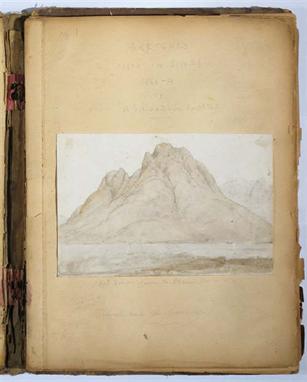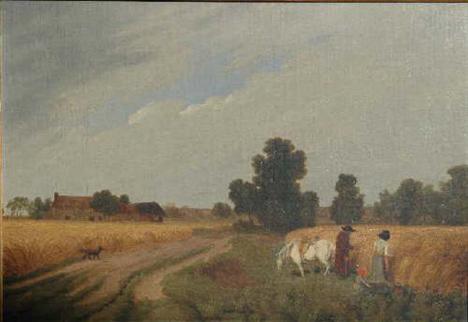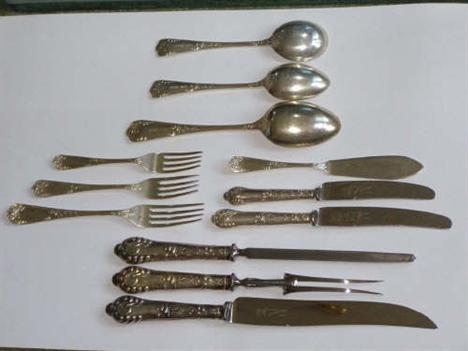We found 297887 price guide item(s) matching your search
There are 297887 lots that match your search criteria. Subscribe now to get instant access to the full price guide service.
Click here to subscribe- List
- Grid
-
297887 item(s)/page
W. S. Goodwin Corporal R. E. (mid 19th Century)Two albums of sketches of Egypt including Feiran, Serbal and CairoBoth with frontispiece inscribed Sketches made in Sinai by W.S. Goodwin Corpl R.E. 1868-9All pencil and watercolourEach album 37 x 27cm; 141/2 x 101/2in, each album with approx. 130 drawingsTogether with 3 framed watercolour studies of desert trees by the same handAlthough some of these sketches show a possible influence from Albert Goodwin it is unlikely that they are by the W. S. Goodwin who was his nephew and who died in 1916 as there is no record of him ever serving in the Royal Engineers.++Covers very poor condition, leaves loose, frayed, yellowed, sketches mainly good, some foxed. Framed watercolours some marks.
Captain Edward "Teddy" Evans (British, 1881-1957), A Souvenir of a Whinneray Lunch at the Old Hall Club, June 1917, signed lower right "from your simple sailor friend Edward R Evans, Captain, RN, HMS Broke", pen, ink and watercolour, 20 x 32cm (7.8 x 12.48in); and There Aint No War Where I am!, signed upper left "Teddy Evans, HMS Broke", pen and ink (2), 16 x 6cm (5.25 x 2.5in). Provenance: By descent within the family. The Antarctic explorer, Captain Teddy Evans, was second in command on Captain Robert Falcon Scott's ill-fated expedition to the South Pole, 1910 to 1913. He was captain of the exploratory ship Terra Nova. He commanded HMS Broke and later became Admiral and the 1st Baron Mountevans of Chelsea. Teddy Evans is not to be confused with Petty Officer Edgar Evans, who was a member of Scott's polar party and died with his companions on the return journey from the Pole
Robert Farren (British, b.1832), Climming, Bempton Cliffs, Flamborough Head, signed lower right "R Farren 1891", oil on canvas, 54 x 35cm (21.06 x 13.65in). Provenance: From the collection of Sir William Farren. The present painting shows a "climmer" at work at Bempton Cliffs. "Climming" involved lowering men over the edge of the cliffs to collect eggs from nesting sea birds, and was used to supplement income. A dangerous practice with virtually no safety equipment, the climmer is wearing nothing but a cap stuffed with straw as some protection against falling rocks from above, and a Guernsey jumper. Three to four hundred eggs could be collected in a day. Guillemot eggs, which are large for the size of bird, were particularly sought after. Despite the danger, few accidents were recorded. The practice declined after the Second World War but continued until 1954 when it was finally made illegal
William Turner of Oxford OWS (1789-1862), A farmer and his family on the edge of a corn field, oil on canvas, the stretcher signed or inscribed and numbered 'No. 2, Wm. Turner, Oxford', 33 x 48 cm (13 x 19 in), in a carved and gilt rococo frame. Provenance: L. R. Phelps, Provost of Oriel College; his sale, 2nd October 1929, lot 122. Exhibited: William Turner of Oxford, Woodstock, London and Bolton, 1984/85. A photograph in the Witt Library identifies this picture as 'Cornfields near Radley'
An interesting group of eight First and Second World War medals awarded to Captain Arthur R. Cossar, Merchant Navy, comprising 1914-18 War Medal and 1914-18 Mercantile Marine War Service Medal, 1939-45 War Medal, Atlantic, Pacific, Africa and 1939-1945 Stars and Elizabeth II Coronation Medal, together with associated medal ribbons and Merchant Navy insignia, and a 1914-18 War Medal awarded to 2225 S. B. E. Morris, Dk. Boy, R. N. R.
Christopher Richard Wynne Nevinson (1889-1946), 'A Dawn, 1914', drypoint, signed and inscribed '1914' in pencil, plate size 20 x 15 cm (8 x 6 in). Exhibited: Exhibition of Works by C. R. W. Nevinson, Leicester Galleries, September/October 1916 (no. 33, bought by Professor Michael Sadler). It was the success of this first solo exhibition that led to Nevinson's appointment as an official war artist.
Two Victoria Queen South Africa medals, one with seven bars - Relief of Kimberley, Paardeberg, Cape Colony, Orange Free State, Transvaal, South Africa 1901, and South Africa 1902, to "6013 Pte. R. Rusted, Yorkshire Regiment", and the other with three bars - Cape Colony, Transvaal and Wittebergen, to "2443 Pte. W. Rowlands, Second RL. West Kent Regiment".
A late 17th/early 18th Century Dutch oak and marquetry longcase clock by Bernard Van der Cloesen of The Hague, the 12ins square brass dial with wide silvered chapter ring with Roman and Arabic numerals, the matted dial centre with turned winding holes showing phases of the moon and calendar work and with cast brass cherub's head spandrels to the eight day two train five pillar movement with alarum, Dutch striking on two bells, contained in oak and marquetry case inlaid with birds, ribbon and trailing leaf and floral motifs, the hood with stepped pagoda top and plain turned pillars to hood, the trunk door with oval lentical, on plinth base, 90ins high, Note : Bernard van der Cloesen (ante 1650-1736) was born in Emmerik and having been married in the Hague, became a citizen of the city in 1688. With the establishment of the Clockmaker's Guild in 1688 he became Warden and later Master. In 1699 succeeded Lubbertus van der Burgh as City Clockmaker for the Hague, being succeeded by one his sons, also Bernard, in 1735. In 1694 van der Cloesen made Christian Huygens last clock for measuring longitude at sea. See Dr. R. Plomp, Spring Driven Dutch Pendulum Clocks 1657-1710 Schiedam 1979 for illustrations.
A modern 12 place setting of silver cutlery, the double struck handles in a floral art nouveau taste, comprising 6 table spoons, 12 soup spoons, 12 dessert spoons, 9 teaspoons, 12 dinner forks, 11 dessert forks, 12 dinner knives, 12 tea knives, 12 coffee spoons, 12 fish forks, 12 fish knives and a three piece silver-handled carving set - blades to knives in stainless steel - R&D, Sheffield 1963-1966 - 169oz of weighable silver (125)
A Georgian Cavalry Sword, the 76cm single edge broad fullered steel blade engraved R E within a shield and ribbon border "Yorkshire Militia", with coat of arms, martial trophy and signed Gill's Warranted, the gilt brass stirrup hilt with wire bound chequered ivory grip and lion head pommel, with silver bullion sword knot (lacks scabbard)
SHOTGUN CERTIFICATE REQUIRED FOR THIS LOT A 12 Bore Double Barrel Side by Side Non-ejector Shotgun by W R Pape, Newcastle, the 76cm nitro proof steel barrels numbered 11522, the rib engraved W R Pape, Newcastle-upon-Tyne, Winner of the London Gun Trials 1858.1859,1866 & 1875, with signed box lock, over-lever break, slide safety, chequered walnut pistol grip butt and fore-end.
Three First World War Pairs:- 1914-15 Star (re-named) and Victory Medal awarded to 2608 PTE.E.YATES. E.LAN.R.; British War Medal and Victory Medal awarded to 24433 PTE.J.OWEN. E.LAN.R., and 277582 PTE.J.W.BRADLEY. MANCH.R.; two Single Victory Medals, to 27389 PTE.W.TAYLOR.R.LANC.R., and 77637 PTE.H.NORCROSS. L'POOL R. (8)
-
297887 item(s)/page

















































